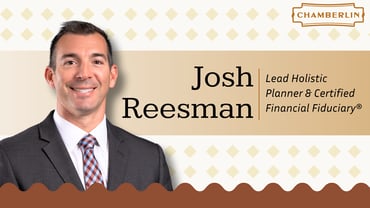Meet Lead Holistic Planner Josh Reesman
One of the things that makes Chamberlin unique is that we ...

One of the things that makes Chamberlin unique is that we ...

What does retirement mean to you? Is it just being done with a ...

Do you remember when you used to get all of your investment ...

Your 401(k) is more than just a savings account — it’s one of ...

One of the main goals of retirement planning is to steward ...

“I view Chamberlin as like being on an airplane. When there's ...

Chamberlin is proud to have made Inc.'s 2025 Best Workplaces ...

There are a lot of people you think about when you consider ...

Here's the real question: Will that money last? You've won the ...

Factors such as position, noteworthy accomplishments, ...
Investment advisory services are offered through Foundations Investment Advisors, LLC (“Foundations”), an SEC registered investment adviser. Nothing on this website constitutes investment, legal or tax advice. Any historical performance data is solely illustrative and provided as general information and is not a prediction of any future results or any past results for any specific client of Foundations. This website and its contents do not make any recommendation that any particular security, portfolio of securities, transaction, investment, or planning strategy is suitable for any specific person. Personalized investment advice can only be rendered after the engagement of Foundations, execution of required documentation (including a client agreement), and receipt of required disclosures. Investments in securities involve the risk of loss, including a total loss of money invested. Any past performance is no guarantee of future results. Advisory services are only offered to clients or prospective clients where Foundations and its advisors are properly licensed or exempt from licensure; Foundations reserves the right to accept or reject any prospective client. For more information about us, please go to https://adviserinfo.sec.gov and search by our firm name or by our CRD #175083
Consulting Nationally Via Zoom
12444 Powerscourt Drive Suite 100
Saint Louis, MO 63131
Toll-free: (833) 823 - 3330
Phone: (314) 909 - 1100
Fax: (314) 909 - 1269